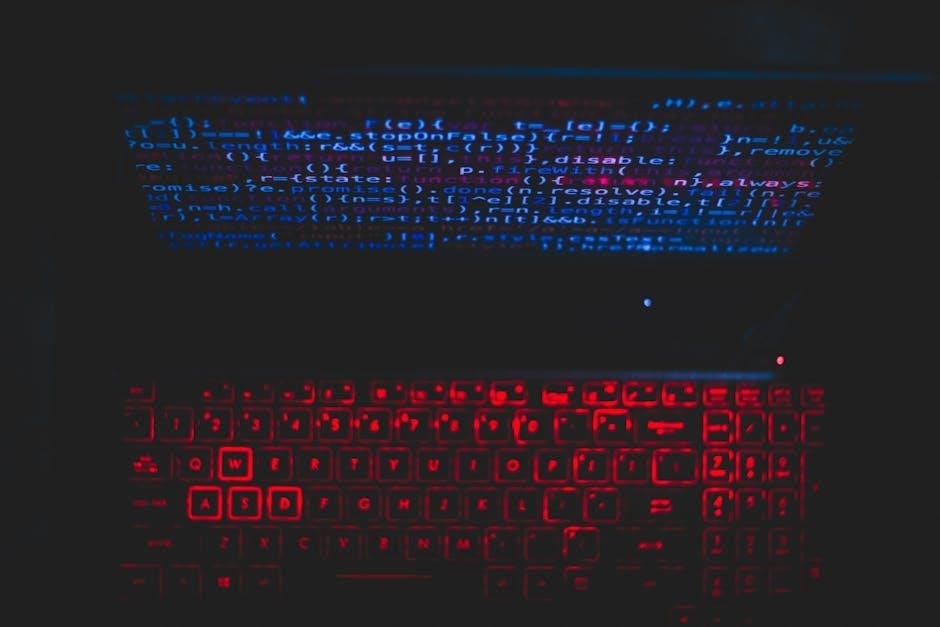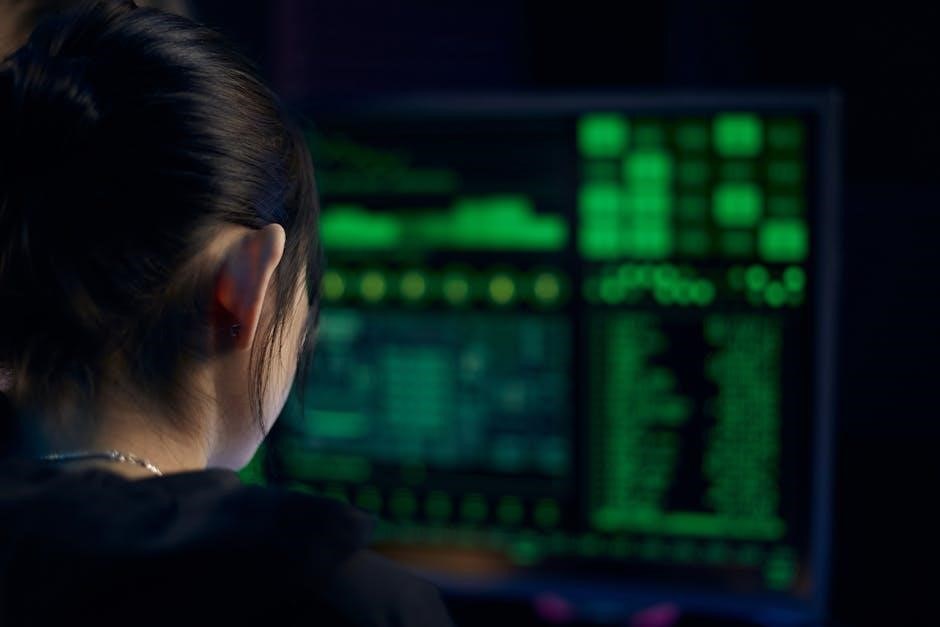CPT (Current Procedural Terminology) codes are standardized codes used to describe medical, surgical, and diagnostic services. They ensure accurate billing and insurance reimbursement for procedures like biopsies.
1.1 What Are CPT Codes?
CPT (Current Procedural Terminology) codes are standardized codes used to describe medical, surgical, and diagnostic services. They are essential for accurate billing, insurance claims, and medical documentation. CPT codes are maintained by the American Medical Association (AMA) and are updated annually to reflect advancements in medical practices. These codes provide a uniform language for healthcare providers to communicate the services they perform. Each code represents a specific procedure or service, ensuring consistency and clarity in medical billing and record-keeping across the healthcare industry.
1.2 Importance of CPT Codes in Medical Billing
CPT codes are crucial for standardizing medical billing and ensuring accurate reimbursement for healthcare services. They provide a universal language for describing procedures, making it easier for healthcare providers to communicate with insurers. In the context of a CT-guided kidney biopsy, CPT codes like 50200 and 77012 ensure that both the procedure and imaging guidance are properly documented. This precision helps avoid billing errors, ensures compliance with regulations, and facilitates smooth insurance claims. Accurate CPT coding also supports data collection for healthcare quality improvement and resource allocation, making it indispensable for efficient medical billing and administration.

Understanding CT-Guided Kidney Biopsy
A CT-guided kidney biopsy involves using computed tomography imaging to direct the precise removal of kidney tissue for diagnostic examination, ensuring accuracy and minimizing complications.
2.1 Definition and Purpose
A CT-guided kidney biopsy is a diagnostic procedure where computed tomography (CT) imaging directs the insertion of a needle to collect kidney tissue samples. This method ensures precise targeting of the kidney tissue under real-time imaging guidance. The primary purpose is to assess kidney function, detect abnormalities, and diagnose conditions such as kidney disease, inflammation, or cancer. It is also used to monitor transplanted kidneys and evaluate unexplained symptoms like proteinuria or hematuria. The CT guidance enhances accuracy, minimizing complications and ensuring safe tissue collection for pathological examination.
2.2 Role of CT Guidance in Biopsy
CT guidance plays a pivotal role in kidney biopsies by providing real-time imaging to accurately direct the needle to the target site. This enhances precision, reducing the risk of complications such as bleeding or damage to surrounding structures. CT imaging allows for clear visualization of the kidney anatomy, enabling the physician to select the optimal biopsy location. It is particularly useful in cases where the kidney is difficult to access or when abnormalities are subtle. The use of CT guidance improves patient safety and ensures effective tissue sampling for diagnostic purposes.
CPT Code for Kidney Biopsy Procedure
CPT code 50200 is used for percutaneous kidney biopsy procedures, where a needle or trocar is inserted to obtain tissue samples for diagnostic analysis under imaging guidance.
3.1 Overview of CPT Code 50200
CPT code 50200 refers to a percutaneous kidney biopsy procedure, where a needle or trocar is used to obtain tissue samples for diagnostic purposes. This code is specifically designed for renal biopsies performed under imaging guidance, such as CT scans, to ensure precision and safety. The procedure involves the insertion of a biopsy needle into the kidney tissue, typically under local anesthesia, to collect specimens for histopathological examination. CPT code 50200 is essential for billing and reimbursement purposes in medical practices, accurately representing the technical and professional services provided during the biopsy process.
3.2 What the Code Includes
CPT code 50200 includes the procedure of percutaneous kidney biopsy, involving the use of a needle or trocar to obtain tissue samples. It covers the insertion of the biopsy needle under imaging guidance, such as CT scans, to ensure accurate tissue collection. The code also includes the use of local anesthesia to minimize patient discomfort during the procedure. Additionally, it encompasses the collection of kidney tissue samples for histopathological examination, which is crucial for diagnosing kidney disorders. This code is essential for billing purposes, representing the technical and professional services provided during the biopsy process.
3.3 When to Use Code 50200
CPT code 50200 is used for percutaneous kidney biopsy procedures performed under imaging guidance, such as CT scans. It applies when a physician uses a needle or trocar to collect kidney tissue samples for diagnostic purposes. This code is appropriate for cases involving suspected kidney disease, cancer, or transplant complications. It should be billed when the procedure is performed percutaneously, not as an open surgical biopsy. The code does not apply to biopsies performed during open surgery or laparoscopic procedures, which require different coding. Ensure the procedure meets the criteria for percutaneous biopsy to use this code accurately.

CPT Code for CT Imaging Guidance
CPT code 77012 is used for CT imaging guidance during procedures like kidney biopsies, ensuring precise needle placement and accurate tissue sampling under radiological supervision.
4.1 Overview of CPT Code 77012
CPT code 77012 refers to computed tomography (CT) guidance for needle placement during procedures like biopsies or aspirations. This code is used to document the imaging supervision and interpretation provided by a radiologist or physician during the procedure. It ensures accurate and safe placement of the needle, minimizing complications. The code is essential for billing purposes, as it captures the radiological expertise required to guide such interventions. It is commonly used in conjunction with other procedure codes, such as 50200 for kidney biopsies, to comprehensively report the services rendered during a CT-guided biopsy.
4.2 What the Code Includes
CPT code 77012 includes the use of computed tomography (CT) imaging to guide needle placement during procedures such as biopsies or aspirations. It encompasses the radiologist’s supervision and interpretation of the imaging to ensure precise and safe needle placement. The code also covers the technical components of the CT scan, including the equipment and staff required for the procedure. Additionally, it documents the fluoroscopic images used to monitor the needle’s trajectory in real time, ensuring accuracy and minimizing complications. This code is specifically for the imaging guidance aspect and does not include the biopsy procedure itself, which is reported separately using codes like 50200.
4.3 When to Use Code 77012
CPT code 77012 is used when CT imaging is employed to guide needle placement during procedures such as biopsies, aspirations, or drainages. It is appropriate for cases requiring real-time imaging to ensure precise targeting of the lesion or area of interest. This code should be reported when CT guidance is necessary to enhance the accuracy and safety of the procedure. For example, it is commonly used during kidney biopsies or other abdominal procedures where CT imaging provides critical anatomical detail. The code is billed separately from the primary procedure code, such as 50200 for the biopsy itself.
Using Codes 50200 and 77012 Together
CPT codes 50200 and 77012 are used together when a kidney biopsy is performed under CT guidance, ensuring accurate billing for both the procedure and imaging support.
5.1 Billing for Combined Services
When performing a CT-guided kidney biopsy, both the procedure and imaging guidance are billed separately using CPT codes 50200 and 77012. This ensures accurate reimbursement for the combined services. The biopsy procedure (50200) covers the surgical aspect, while the imaging guidance (77012) accounts for the CT scan’s role in navigating the needle. Proper documentation is essential to justify the use of both codes, ensuring compliance with billing guidelines. This dual coding reflects the collaborative nature of the procedure, where both surgical and diagnostic imaging expertise are required for success. Separate billing avoids unbundling issues and ensures proper payment for each service provided.
5.2 Importance of Separate Coding
Separate coding for CPT codes 50200 and 77012 ensures accurate reimbursement and avoids billing errors. Code 50200 represents the biopsy procedure, while 77012 accounts for CT imaging guidance. This distinction prevents unbundling issues and ensures each service is appropriately compensated. Proper separation also enhances transparency, making it easier for payers to understand the services provided. Compliance with coding guidelines is maintained, reducing the risk of denied claims. By coding each component separately, healthcare providers can accurately reflect the complexity and resources involved in a CT-guided kidney biopsy, ensuring fair payment for both the procedure and imaging support.
Related CPT Codes and Procedures
Related codes include 76942 for ultrasound-guided biopsies and 77002 for other imaging guidance. These codes assist in accurate billing for various biopsy procedures, ensuring proper reimbursement.
6.1 Ultrasound-Guided Biopsy (CPT 76942)
CPT code 76942 refers to ultrasound-guided biopsy procedures, including imaging supervision and interpretation. It is commonly used for kidney biopsies when ultrasound is the preferred imaging modality. This code applies to real-time ultrasound guidance during needle placement, ensuring precise tissue sampling. Unlike CT guidance, ultrasound offers portability and avoids radiation exposure, making it ideal for patients with contraindications to CT scans. Proper documentation is essential to differentiate it from other imaging-guided biopsies. Accurate coding ensures appropriate reimbursement for this procedure, which is critical for diagnosing kidney diseases and other conditions requiring tissue analysis.
6.2 Additional Imaging Codes (e.g., 77002)
CPT code 77002 refers to fluoroscopic guidance for needle placement during biopsy or aspiration. It is often used alongside other codes when multiple imaging modalities are employed. For instance, 77012 is specific to CT guidance, while 77000 pertains to radiologic guidance. These codes ensure precise billing for imaging services in procedures like kidney biopsies. Accurate coding is crucial to avoid claim denials and ensure proper reimbursement. Understanding these codes helps in distinguishing between different imaging techniques used in biopsy procedures, ensuring compliance with billing guidelines and avoiding unbundling errors. Proper documentation of imaging services is essential for accurate coding.

Coding Guidelines and Compliance
Adherence to CPT coding guidelines ensures accurate billing and avoids denials. Proper use of modifiers and documentation is essential for compliance with regulations and optimal reimbursement.
7.1 General Coding Rules
Accurate CPT coding requires precise documentation of medical procedures. For CT-guided kidney biopsies, ensure codes reflect the procedure’s complexity and imaging guidance. Use modifiers like -59 to indicate separate services. Avoid unbundling codes, as this can lead to claim denials. Verify patient records match billed codes, ensuring compliance with payer guidelines. Proper sequencing of codes is essential for accurate reimbursement. Always reference the latest CPT manual for updates and specific coding instructions.
7.2 Avoiding Common Billing Errors
Common billing errors for CT-guided kidney biopsies include missing or incorrect documentation, such as patient demographics or procedure details. Ensure CPT codes 50200 and 77012 are used appropriately, avoiding mismatches between codes and services. Incorrect use of modifiers, like omitting -59 for distinct services, can lead to denials. Double-check place-of-service coding, as errors here are frequent. Avoid bundling codes for separate procedures, as this violates payer rules. Overcoding or undercoding can result in audits or reduced reimbursement. Always verify documentation supports billed services to prevent claim denials and ensure compliance with coding guidelines.

Clinical Scenarios for Code Usage
CPT codes 50200 and 77012 are used for kidney biopsies with CT guidance. They apply in diagnosing kidney disease, cancer, or infections, ensuring accurate tissue sampling and imaging.
8.1 Suspected Kidney Disease
When kidney disease is suspected, a CT-guided kidney biopsy is often performed to obtain tissue samples for diagnostic evaluation. CPT code 50200 is used for the biopsy procedure, while code 77012 applies to the CT imaging guidance. This combination ensures precise needle placement, minimizing complications. The biopsy helps diagnose conditions like glomerulonephritis, chronic kidney disease, or other renal disorders. Accurate coding is essential for proper reimbursement and reflects the medical necessity of the procedure in evaluating kidney function and pathology.
8.2 Cancer Diagnosis
CT-guided kidney biopsy is critical in diagnosing renal cancer or metastatic disease. CPT code 50200 is used for the biopsy procedure, while code 77012 applies to the CT imaging guidance. This approach ensures precise tissue sampling from suspicious masses, aiding in accurate cancer staging and treatment planning. The combination of these codes reflects the integration of diagnostic imaging and surgical intervention, ensuring proper reimbursement for comprehensive patient care in oncology settings. Accurate coding is vital for documenting the clinical necessity of the procedure in cancer diagnosis and management.
Reimbursement and Billing Tips
Use separate codes for biopsy (50200) and CT guidance (77012) to avoid service bundling. Correct modifiers ensure accurate reimbursement and prevent claim denials. Proper documentation supports medical necessity.
9.1 Avoiding Unbundling Services
Avoid unbundling services by ensuring that each procedure is coded separately and appropriately. For CT-guided kidney biopsies, code 50200 is used for the biopsy itself, while code 77012 is specifically for the imaging guidance. Billing these codes together ensures proper reimbursement, as they represent distinct services. Unbundling occurs when a single code is split into multiple codes, which is not necessary here since 50200 and 77012 are designed to be billed separately. Always verify that each code reflects a unique service to prevent claim denials and compliance issues. Proper coding practices ensure accurate payment and reduce the risk of audits or penalties.
9.2 Using Modifiers Correctly
Modifiers are critical for accurate billing and prevent claim denials. For CT-guided kidney biopsies, modifiers like -59 (Distinct Procedural Service) may be used if multiple procedures occur during the same encounter. This modifier ensures separate reimbursement for services like biopsy (50200) and imaging guidance (77012). Always verify when modifiers are required, as incorrect usage can lead to denied claims. For example, -26 (Professional Component) might apply if only the imaging supervision is billed. Proper modifier usage ensures compliance with coding guidelines and avoids unnecessary audits. Refer to the AMA CPT manual for precise modifier application rules.
9.4 Documentation Best Practices
Accurate and detailed documentation is essential for proper billing of CT-guided kidney biopsies. Ensure the medical record includes the patient’s history, diagnosis, and rationale for the biopsy. Document the procedure’s technical details, such as the use of CT guidance (CPT 77012) and the biopsy technique (CPT 50200). Include imaging findings, biopsy site, and any complications. Clearly note the medical necessity for CT guidance, as payers may require justification. Maintain records of pre- and post-procedure care, patient consent, and test results. Proper documentation ensures compliance with coding guidelines and prevents claim denials. Always verify that all services billed are supported by thorough documentation.

Common Reasons for Claim Denials
Claims for CT-guided kidney biopsies may be denied due to missing documentation, incorrect CPT code usage, or lack of medical necessity justification. Ensure accurate coding and detailed records.
10.1 Missing Information
Missing or incomplete information is a leading cause of claim denials for CT-guided kidney biopsies. Common omissions include patient demographics, procedure details, or medical necessity documentation. Payers often deny claims when the CPT codes 50200 or 77012 are submitted without supporting evidence, such as imaging reports or biopsy results. Additionally, failure to include modifiers or place-of-service designations can result in denials. Ensuring all required fields and documentation are complete and accurate is critical to avoiding delays or rejected claims for this procedure.
10.2 Incorrect Code Usage
Incorrect code usage is another common reason for claim denials in CT-guided kidney biopsies. Using the wrong CPT code, such as applying 77012 for non-imaging guidance or misapplying 50200 for procedures it doesn’t cover, can lead to rejections. Additionally, modifiers may be misapplied, causing coding errors. For example, using 77012 without properly documenting CT guidance or failing to pair it with 50200 when required can result in denied claims. Always verify CPT codes against the procedure performed and ensure compliance with coding guidelines to prevent such issues. Proper training and regular updates on coding changes are essential to avoid these mistakes.
Future Trends in CPT Coding
Future trends in CPT coding include updates to reflect advancements in medical technology and procedures. New codes may emerge for specialized imaging-guided biopsies, ensuring precise billing and documentation.
11.1 New and Updated Codes
Regular updates to CPT codes ensure they align with medical advancements. For CT-guided kidney biopsies, new codes may address emerging imaging techniques or procedural variations. Recent updates often clarify billing guidelines for combined services, such as biopsy and imaging. For instance, code 50200 for the biopsy and 77012 for CT guidance may see revisions to improve accuracy. Staying informed about these changes is crucial for precise billing and compliance with coding standards. Updates also reflect new technologies, ensuring codes remain relevant and effective for modern medical practices.
11.2 Staying Informed
Staying informed about CPT code updates is essential for accurate billing and compliance. The AMA regularly releases new codes and revisions, which can be found in the annual CPT manual or online updates. For CT-guided kidney biopsies, subscribers to the AMA CPT updates receive notifications about changes to codes like 50200 or 77012; Additionally, resources like the AAPC (American Academy of Professional Coders) provide training and webinars to help coders stay current. Regularly reviewing official coding guidelines and attending industry workshops ensures that medical billers and coders remain up-to-date with the latest coding practices and regulations.
Resources and References
Key resources include the AMA CPT manual, AAPC coding guides, and CMS guidelines, providing detailed information on CPT codes for medical procedures and billing accuracy.
12.1 AMA CPT Manual
The AMA CPT Manual is the official source for Current Procedural Terminology codes, providing detailed descriptions and guidelines for medical procedures. It includes codes like 50200 for kidney biopsies and 77012 for CT guidance, ensuring accurate billing and compliance. The manual is updated annually to reflect changes in medical practices and technologies. It serves as a critical resource for coders, healthcare providers, and billing specialists to ensure proper documentation and reimbursement. By referencing the AMA CPT Manual, professionals can verify code usage, avoid errors, and stay informed about the latest coding standards and revisions.
12.2 Additional Medical Resources
Beyond the AMA CPT Manual, additional resources like the AAPC (American Academy of Professional Coders) and AHIMA (American Health Information Management Association) provide supplementary coding guidelines. These organizations offer updates, webinars, and tools to help coders stay current with CPT codes. The CMS (Centers for Medicare & Medicaid Services) guidelines also provide clarification on billing and reimbursement rules. Online platforms like Codify by AAPC and coding forums offer practical examples and expert advice. Staying informed through these resources ensures accurate coding for procedures like CT-guided kidney biopsies, using codes such as 50200 and 77012, and maintains compliance with industry standards.
CPT codes 50200 and 77012 are crucial for accurate billing of CT-guided kidney biopsies. Proper coding ensures compliance and prevents claim denials, optimizing reimbursement processes effectively.
13.1 Summary of Key Points
CPT codes 50200 and 77012 are essential for billing CT-guided kidney biopsies. Code 50200 represents the biopsy procedure, while 77012 covers CT imaging guidance. Proper coding ensures accurate reimbursement and compliance with medical billing standards. Understanding these codes is vital for healthcare providers to avoid claim denials and optimize billing processes. Regular updates to CPT codes highlight the importance of staying informed to maintain compliance and efficiency in medical billing practices.
Accurate documentation and correct code usage are critical to avoid common billing errors. Familiarity with CPT guidelines ensures seamless reimbursement for procedures like CT-guided kidney biopsies.
13.2 Final Thoughts
Accurate use of CPT codes 50200 and 77012 is crucial for proper billing and reimbursement in CT-guided kidney biopsies. These codes ensure clarity and compliance in medical billing processes. Staying updated with CPT guidelines and best practices helps avoid errors and ensures efficient reimbursement; Proper documentation and understanding of code applications are vital for healthcare providers. By adhering to these standards, medical professionals can streamline billing and focus on delivering high-quality patient care. Continuous education on CPT coding is essential to adapt to evolving medical billing requirements.